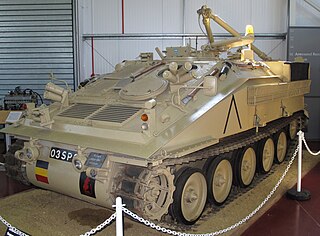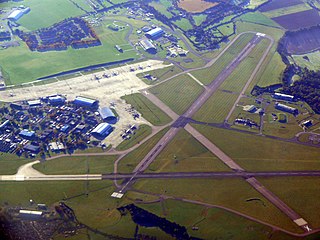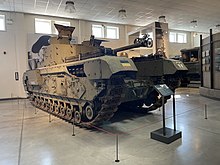This is the Operation Telic order of battle, which lists the British forces that took part in Operation Telic, including

Ministry of Defence Lyneham or MOD Lyneham is a Ministry of Defence site in Wiltshire, England, about 7 miles (11 km) north-east of Chippenham and 10 miles (16 km) south-west of Swindon. The site houses the Defence School of Electronic and Mechanical Engineering. Also here is Prince Philip Barracks, housing the regimental headquarters of the Royal Electrical and Mechanical Engineers (REME), 8 Training Battalion REME and the REME Museum.

A beach armoured recovery vehicle (BARV) is an armoured recovery vehicle used for amphibious landings.

The Corps of Royal Electrical and Mechanical Engineers is the maintenance arm of the British Army that maintains the equipment that the Army uses. The corps is described as the "British Army's professional engineers".
Options for Change was a restructuring of the British Armed Forces in summer 1990 after the end of the Cold War.

FV106 Samson was a British Army armoured recovery vehicle, one of the CVR(T) family. The main role of this vehicle was to recover the CVR(T) family of vehicles, but could also recover other light tracked vehicles such as the FV430 series.

The FV 214 Conqueror, also known as tank, heavy No. 1, 120 mm gun, Conqueror was a British heavy tank of the post-World War II era. It was developed as a response to the Soviet IS-3 heavy tank. The Conqueror's main armament, an L1 120 mm gun, was larger than the 20-pounder (83.4 mm) gun carried by its peer, the Centurion. The Conqueror's role was to provide long range anti-tank support for the Centurion. Nine Conquerors were issued for each regiment in Germany, usually grouped in three tank troops. In the British Army both the Conqueror and the Centurion were replaced by the Chieftain.

Bordon Camp was a British Army camp close to the settlement of Bordon in Hampshire, England. The camp, which was latterly maintained by the Defence Infrastructure Organisation, opened in 1863 and closed in 2015.
The Army Apprentices College was a college system in the United Kingdom that offered military training, education and common core skills, leadership and adventurous training, character development and trade training.
This is the Operation Herrick ground order of battle, which lists any British ground forces that have taken part in the duration of Operation Herrick between 2002 and 2014.

Arborfield Green is a new village approximately 1 mile (1.6 km) south east of the village of Arborfield Cross in the English county of Berkshire, previously a British Army garrison called Arborfield Garrison. The army vacated the site in 2015 and it is now being redeveloped for housing, with a total of 3,500 homes planned. The Garrison and its associated housing estates are split between the civil parishes of Arborfield and Newland, Barkham, Finchampstead, and Swallowfield. Both parishes are within the unitary authority of Wokingham. According to the Post Office, the majority of the 2011 Census population was included in the civil parish of Barkham. As of 2023, the new village centre is still under construction.

The Sri Lanka Electrical and Mechanical Engineers (SLEME) (Sinhala: ශ්රී ලංකා විදුලි හා යාන්ත්රික ඉංජිනේරු රෙජිමේන්තුව Shri Lanka Viduli Ha Yanthrika Injineru Rejimentuwa) is a Combat Support corps of the Sri Lanka Army. It is made up of six regular regiments and one volunteer (reserve) regiment. Regiment Center located at Kew Road, Slave Island, Colombo. The present strength of the corps is 200 officers and 5763 other ranks.
The Defence School of Electronic and Mechanical Engineering (DSEME) is one of four Defence Schools within the Defence College of Technical Training (DCTT) of the British Ministry of Defence. It was formed on 1 Apr 2010 and comprises a Headquarters, the British Army's 8 Training Battalion of the Royal Electrical and Mechanical Engineers (REME), and the REME Arms School all based at MOD Lyneham, and the Royal Air Force's No. 4 School of Technical Training at MOD St Athan.

The FV434 is the Armoured Repair Vehicle variant of the British Army's FV430 series of armoured fighting vehicles. Introduced in the 1960s primarily as a means of quickly changing Chieftain MBT power packs in the field, it is operated by the Royal Electrical and Mechanical Engineers (REME). It is still used by the REME.

Tidworth Camp is a military installation at Tidworth in Wiltshire, England. It forms part of the Tidworth, Netheravon and Bulford (TidNBul) Garrison.

Royal Air Force Lyneham otherwise known as RAF Lyneham was a Royal Air Force station located 6.3 miles (10.1 km) northeast of Chippenham, Wiltshire, and 10.3 miles (16.6 km) southwest of Swindon, Wiltshire, England. The station was the home of all the Lockheed C-130 Hercules transport aircraft of the Royal Air Force (RAF) before they were relocated to RAF Brize Norton.

Barker Barracks was a military installation in Paderborn, Germany.
The following is a hierarchical outline for the structure of the British Army in 1989. The most authoritative source for this type of information available is Ministry of Defence, Master Order of Battle, and United Kingdom Land Forces, HQ UKLF, UKLF ORBAT Review Action Plan, HQ UKLF, 1990.

Hadrian's Camp was a military installation on the line of Hadrian's Wall at Houghton in Cumbria, England.

The Challenger Armoured Repair and Recovery Vehicle or CRARRV is a large British armoured recovery vehicle based on the hull of the Challenger 1 main battle tank. The CRARRV is currently operated in conjunction with the Challenger 2 tanks of the British Army and Royal Army of Oman. It is one of the few vehicles capable of repairing and recovering Challenger tanks in the field. Eighty vehicles were delivered to the British between 1988 and 1993; an additional four vehicles were delivered to Oman.

















